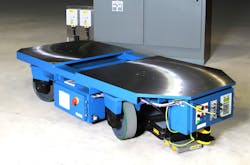In our last blog post we talked about how companies are looking to maximize capacity utilization for every dollar and square foot. Having been burned by the last recession, their new manufacturing technologies must have systems flexible enough to handle future production changes. Also, the total cost of automation must be considered, not just purchase cost.
We’re currently working with large manufacturers to meet both of these requirements, using something we call The Portable Assembly Line. It uses battery-free automated guided vehicles (AGVs) with inductive power transfer (IPT) to create a virtually invisible conveyance that is quickly relocated or rerouted. It allows every operation to be independent of the others, which improves efficiency and also gives a clearer picture of the true cost of automated and manual processes at each station.
As an example of how such AGV systems are being applied, we recently worked with a construction vehicle manufacturer that recently moved production back to the United States from Japan. Traditionally, a company like this would have selected chain based conveyance anchored to the building, requiring thousands of pounds of steel track that is scrapped whenever the line is changed. Instead of this more typical approach, the company wanted something that could be rerouted quickly without wasting tons of steel and investing in tons more.
Installation of the Portable Assmbly Line started with cutting out two shallow floor channels to contain the power and communication cables. The cables are then epoxied over to create a flat floor. Rather than relying on mechanical parts to guide the system, battery-free AGVs rely on integrated software and controls. This makes for a much faster installation and change process, since the floor changes are simple and the software and controls are changed independently. Rather than scrapping tons of steel tracks or digging deep pits into the floor, this approach uses vastly fewer resources to reroute a line.
All of the mechanical, software and controls design, build and test is done in Michigan, where our AGVs and controls are proved out on the IPT Test Track before shipment. This reduces the installation or line change time and risk at the customer even more.
This video shows the installation and testing process, along with some customer footage.
We are also building a battery-free AGV decking system for an automaker. In this application, a vehicle chassis is brought in on overhead conveyance and a battery-free AGV carries the exhaust system to be lifted up and attached to the vehicle by an operator. This application could possible have been performed by robots, but when we reviewed the complete cost of a fully automated solution throughout its lifecycle, retaining manual operators was seen by the customer as being the right decision.
We find that our customers are requiring that every piece of automation earn its spot in the manufacturing process. This means that, not only purchase price, but operator safety, maintenance and repair costs all go into the equipment purchase decision. As integrators, this requires us to gather and understand not only our costs, but our customers’ costs of doing business.
Rod Emery is vice president at RedViking in Plymouth, Mich. RedViking is a member of the Control System Integrators Association. For more info on this technology, please feel free to contact Rod directly at [email protected]. Rod will be presenting a case study on battery-free AGV assembly lines at The Automation Conference 2014.

Leaders relevant to this article:
